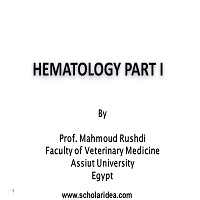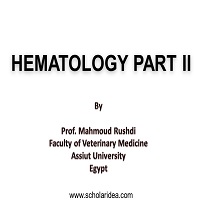Definition:
It is defined as the rate of sedimentation of erythrocytes in a column of anti-coagulated blood at a certain time.
Methods:
– Wintrobe method.
– Westergreen method.
The type of the anticoagulant used for ESR is different according to the method used. EDTA is used for ESR that determined by wintrobe method. However, Sodium Citrate (3.8%) is used for ESR that determined using the westergreen method, sodium citrate is used in the ratio of 1:4.
Suitable time for ESR:
ESR must be measured within a certain time, the time is different between animal species.
Equine: 10 minutes and 20 minutes
Cattle: after 24 hrs
Dogs: 1hour and 2hour
Sheep: 7hrs and 24hrs
Buffaloes: 1 hour
Principle of the test:
A whole blood sample is allowed to stand for a certain time in a perpendicular tube, The erythrocytes are settling down, leaving a clear layer of plasma at the top of the tube. The length of the plasma layer in mm represent is a measure of the ESR and expressed as mm/time.
ESR is considered a nonspecific test for inflammation. Also, it can be affected by other disorders like anaemia and polycythaemia.
The fact of increased ESR in case of inflammation is based on the increased plasma fibrinogen, which aggregate the erythrocytes, and consequently increase the rate of sedimentation of RBCs.
Physical Factors affecting ESR:
-The test must be carried out at room temperature (20-25C), higher environmental temperature results in accelerated ESR and low environmental temperature results in slow ESR.
-The tube must be in a perpendicular position, inclined tube results in accelerated ESR.
-The anticoagulant must be used in the proper concentration and dilution. Increase the volume of the anticoagulant solution used results in dilution of blood and accelerated ESR. On the other hand, increase the amount of the powder anticoagulant results in increased the viscosity of blood and consequently slow ESR.
Pathological factors:
– Increase the size of the RBCs results in slow ESR, and vice versa.
– Increase the number of RBCs results in slow ESR, and vice versa.
– Decrease the volume of plasma as in case of dehydration results in slow ESR.
– Oligocythaemia is associated with accelerated ESR.
– All cases of inflammation either acute or chronic results in accelerated ESR, due to the increased level of plasma fibrinogen.






